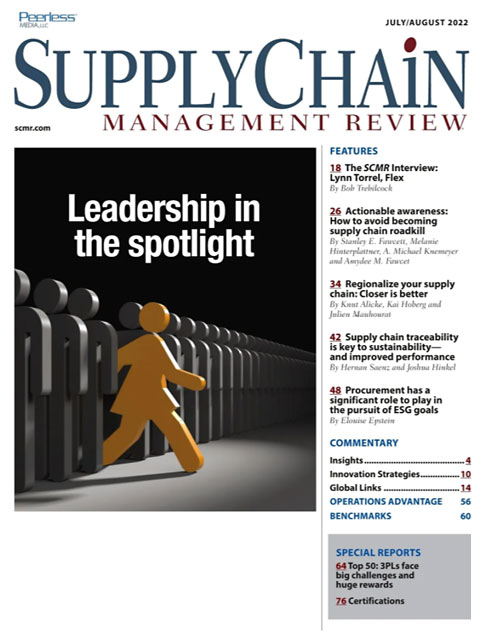Sorry, but your login has failed. Please recheck your login information and resubmit. If your subscription has expired, renew here.
July-August 2022
In late May, I attended the Institute for Supply Management’s first live conference since 2019. The message from Tom Derry, ISM’s CEO, was simple: These are challenging times, but along with the challenges come opportunities for those of us who can step up and lead our organizations into the future. One area where supply chain will be tasked with stepping up to the plate is going to be ESG, the initialism for environmental, social and governance. It was a major theme of the conference, and while all of the reporting requirements are still being debated, there’s little question that supply chain will lead the charge in environmental initiatives… Browse this issue archive.Need Help? Contact customer service 847-559-7581 More options
For decades, major North American companies have been playing the equivalent of golf’s long game by operating global supply chains extending over vast distances. But several years of trade wars and tariffs, successive waves of COVID and Russia’s invasion of Ukraine have made the vulnerability of global supply chains vividly clear. Companies continue to struggle through ongoing supply disruptions, congested ports and skyrocketing charges—the average cost of transporting a container rose from $1,362 in November 2019 to between 10 times and 15 times that amount at the height of COVID. It was still hovering around $9,600 early in 2022. At the same time, demands on supply chains are heightened as consumers and customers expect more timely delivery and more personalized service.
Today’s turmoil is triggering the biggest remaking of the global operating environment in our lifetime. Kearney’s Global Business Policy Council warns that prolonged conflict and retaliatory economic sanctions may lead to a fragmentation of the post-Cold War global economy into regional hubs shaped by national ideology.
The challenges ahead demand much more than adjusting a few dials. We believe the most successful companies will use the current crisis as an impetus to decisively restructure their value chains for resilience and agility, so that they can keep pace with—or better yet, stay ahead of—what will be an historic change in how markets are defined and operate. For all of these reasons and more, many companies are now strengthening their short game to make the cut and set the stage for
sustained success.
An executive survey conducted in March 2022, in conjunction with Kearney’s annual Reshoring Index benchmark study, suggests that a shift toward reshoring and nearshoring operations is imminent: 92% of manufacturing executives and 78% of CEOs said that they have considered reshoring or have already reshored some manufacturing operations to the United States. Intriguingly, 81% of U.S. manufacturing executives and 62% of CEOs say that seeing other U.S. companies reshore or nearshore would influence them to follow suit (see Figure 1).

This complete article is available to subscribers only.
Log in now for full access or start your PLUS+ subscription for instant access.
SC
MR
Sorry, but your login has failed. Please recheck your login information and resubmit. If your subscription has expired, renew here.
July-August 2022
In late May, I attended the Institute for Supply Management’s first live conference since 2019. The message from Tom Derry, ISM’s CEO, was simple: These are challenging times, but along with the challenges come… Browse this issue archive. Access your online digital edition. Download a PDF file of the July-August 2022 issue.For decades, major North American companies have been playing the equivalent of golf’s long game by operating global supply chains extending over vast distances. But several years of trade wars and tariffs, successive waves of COVID and Russia’s invasion of Ukraine have made the vulnerability of global supply chains vividly clear. Companies continue to struggle through ongoing supply disruptions, congested ports and skyrocketing charges—the average cost of transporting a container rose from $1,362 in November 2019 to between 10 times and 15 times that amount at the height of COVID. It was still hovering around $9,600 early in 2022. At the same time, demands on supply chains are heightened as consumers and customers expect more timely delivery and more personalized service.
Today’s turmoil is triggering the biggest remaking of the global operating environment in our lifetime. Kearney’s Global Business Policy Council warns that prolonged conflict and retaliatory economic sanctions may lead to a fragmentation of the post-Cold War global economy into regional hubs shaped by national ideology.
The challenges ahead demand much more than adjusting a few dials. We believe the most successful companies will use the current crisis as an impetus to decisively restructure their value chains for resilience and agility, so that they can keep pace with—or better yet, stay ahead of—what will be an historic change in how markets are defined and operate. For all of these reasons and more, many companies are now strengthening their short game to make the cut and set the stage for
sustained success.
An executive survey conducted in March 2022, in conjunction with Kearney’s annual Reshoring Index benchmark study, suggests that a shift toward reshoring and nearshoring operations is imminent: 92% of manufacturing executives and 78% of CEOs said that they have considered reshoring or have already reshored some manufacturing operations to the United States. Intriguingly, 81% of U.S. manufacturing executives and 62% of CEOs say that seeing other U.S. companies reshore or nearshore would influence them to follow suit (see Figure 1).
SC
MR


Latest Supply Chain News
- Retail sales see gains in October, reports Commerce and NRF
- Balancing green and speed: Home delivery insights from the pandemic era
- AdventHealth named top healthcare supply chain by Gartner
- Geopolitical readiness in supply chains: Strategic challenges for leaders
- Unlocking retention: The role employee engagement plays
- More News
Latest Podcast

 Explore
Explore
Procurement & Sourcing News
- Retail sales see gains in October, reports Commerce and NRF
- Geopolitical readiness in supply chains: Strategic challenges for leaders
- With capacity to spare, logistics real estate demand remains subdued
- Tariffs, taxes and trade: The impact of Trump’s reelection on the supply chain
- How to improve demand forecasts for new product families
- Aggregators sitting on the throne of Africa’s e-commerce supply chains: What lessons can we learn?
- More Procurement & Sourcing
Latest Procurement & Sourcing Resources

Subscribe

Supply Chain Management Review delivers the best industry content.

Editors’ Picks





